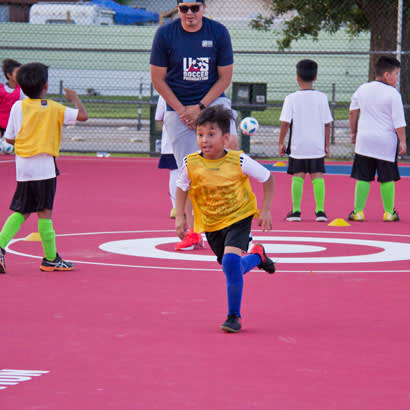
Amid recent discussions about the troubling decline in youth sports participation, there is one fact that is often overlooked: too many children and families don’t have safe places to play in their neighborhoods.
According to The Trust for Public Land, 1 in 3 Americans don’t have a park within a 10-minute walk — or a half-mile — of their home. That’s 100 million people without easy access to a place where they can be active.
At a time when, according to the Centers for Disease Control and Prevention, 1 in 5 school-aged children are obese and 71 percent of youth do not get the recommended amount of physical activity, creating safe places to play where children live and go to school is imperative.
Unfortunately, the problem is magnified for children living in underserved communities who are more than four times as likely to lack recreational facilities. The barriers that can prohibit children from participating in sports only add to other obstacles that families in underserved communities often face, such as lack of access to healthy foods.
Mini-Pitches Offer Creative Solution
At the U.S. Soccer Foundation, we’ve been working for several years to reduce barriers to the sport. Most recently, we’ve focused on creating access to playing spaces in underserved communities that have traditionally lacked large open spaces and the funding to build and maintain full-sized fields. The solution we’ve identified: transforming small, underutilized areas into mini-soccer pitches.
These brightly-colored mini- pitches provide a quality playing surface for both organized soccer programs and pick-up games. The new spaces — created in areas that were previously dilapidated or simply not used — transform the look and feel of communities, help change safety perceptions and build neighborhood cohesion.
Each time I visit a mini-pitch, I’m elated to see the number of girls and boys playing on the spaces. But, I’m not surprised. When you remove barriers and make opportunities to play accessible, incredible things can happen. That’s why we set the ambitious goal to create 1,000 mini-pitches with our partners by 2026. We want neighborhoods everywhere in the United States to have a soccer mini-pitch to play on, just like many neighborhoods have basketball and tennis courts. And, we’re well on our way. Since 2016, we’ve built 150 mini-pitches in communities across the country.
Creating 100 Play Spaces with Target
The movement has taken off thanks to corporate partners, like Target, that have invested in this initiative. As part of a larger commitment to youth soccer, Target teamed up with us to build 100 mini-pitches across the United States by 2020.
This past year, we unveiled new play spaces in Houston, Chicago, Atlanta, Orlando and Tampa. By turning play deserts into safe playing spaces, we’re creating more opportunities for youth to get involved in the sport, play with their friends and be more physically active.
Parks and Recreation’s Instrumental Role in Increasing Access to Play
Another major factor in why U.S. Soccer Foundation has been successful with this initiative can be attributed to our strong partnerships with many park and recreation departments, since they have public spaces that can be easily converted into mini-pitches.
The addition of mini-pitches to park and recreation facilities has reinvigorated play in areas where people weren’t using the existing spaces. Why? Soccer can be played by everyone. The sport attracts girls and boys, adults and children. In short, the mini-pitches match the evolving interests and needs of communities.
Due to their size, mini-pitches can easily be created in pocket parks to maximize access to play within a limited space. They can also enhance unused lots and courts in traditional parks to provide other recreational opportunities for residents.
In addition to free play, many park and recreation departments, other municipal departments and nonprofits utilize the mini-pitches as sites to offer high-quality programming. On many mini-pitches, we work with partners to offer our Soccer for Success afterschool program, which is proven to improve health and social outcomes.
In the past year, we’ve created more than 25 mini-pitches with the Chicago Park District, Houston Parks and Recreation Department and Atlanta Department of Parks & Recreation. And, with each new mini-pitch, we see a transformation of the urban landscape.
A Safe Place to Play in Houston
The impact of these mini-pitches can already be seen in Houston, Texas, where, with Target, we recently opened a double mini-pitch in Eastwood Park. Adrian Juarez, a Houston native and coach-mentor with our Soccer for Success partner, Houston Parks and Recreation, told us that prior to the creation of these mini-pitches, it was hard to find a high-quality field that was open to the public.
Juarez was at the park to unveil the new mini-pitches and could see the impact immediately. “That day at Eastwood, you saw the smiles on the kids’ faces,” he says. “You can see the parents watching their kids having fun, and you hear kids laughing. It’s a great feeling.”
He’s also seen the impact the mini-pitches have on getting youth more active. “Without things like this, we would have a lot less face-to-face interaction, a lot less physical activity because people would be on their technology,” Juarez explains. “Having these mini-pitches available to them, they put down the controller to go play.”
Hector Avila, Soccer for Success program director with Houston Parks and Recreation, says that even non-soccer players have been impacted by the space. “If you walk through the park and you see the way it looks now compared to how it looked before, it makes you feel proud,” Avila shares. “In 10 years, 20 years from now, those courts are going to impact many lives and different generations in so many different ways.”
Note: To bring this transformation to your park, visit getsoccerforsuccess.org.
Ed Foster-Simeon is President and CEO of the U.S. Soccer Foundation.

